Sable Island is a sand bar - 42 km long and roughly 1.5 km wide - located far offshore, approximately 160 km southeast of Canso, Nova Scotia, the nearest landfall. The island has been the focus of human activities, imagination and speculation for roughly 500 years. Shipwrecks, wild horses, seabirds and seals, and inaccessibility have endowed this narrow wind-swept sliver of sand with a special mystique. The island is the subject of extensive scientific research and of numerous documentary films, books and magazine articles.
The most famous, and perhaps the most popular, of Sable Island's fauna are the wild horses. Although access to the island is restricted - both by location and by regulations - the horses are well-known, and are of great interest, culturally and scientifically.
The romantic notion that Sable Island horses are descended from shipwreck survivors persists. The present-day horses, however, are descendants of animals brought to Sable Island during the late 1700s. Introductions of small numbers of domestic horses occurred sporadically during the 1800s and early 1900s. A thorough account of the history of the Sable Island horses is provided by Barbara Christie (1995. The Horses of Sable Island. 2nd Edition. Pottersfield Press)
Most populations of wild horses consist of feral animals (i.e. domesticated animals that have returned to the wild). Such horses are wild in the sense that they are generally free to roam as they please, to form various social organizations, to reproduce, and to forage for their own food and water, and to survive or succumb to disease, weather and predators. However, many of these free-ranging populations are exposed to some form of interference by people - fertility control, culling, round-ups, adoption programs etc. The Sable Island horses are among the few wild horse populations that are entirely unmanaged: they are not subject to any kind of interference. Since 1961, the Sable Island horses have had legal protection under the Sable Island Regulations of the Canada Shipping Act.
The Future for the Sable Island Horses
The number of horses on Sable Island generally ranges between 200 to 350. Although the horses are presently protected by the Sable Island Regulations, this protection exists only so long as the horses and their island habitat are effectively monitored. Since 1801, when the life-saving stations were established, there has been a continuous government presence on Sable Island. Now the future of Sable Island and the Station is in question, and the Government of Canada is considering various options - one of which is to close the Station, thus ending 200 years of full-time human presence and stewardship. This option would put not only the horses, but all the island's flora and fauna at serious risk.
www.greenhorsessociety.com
Conformation and Type of the Sable Island Horse
The Sable Island horses are, by lineage and conformation, horses, not ponies. While there is some variation in size and conformation, Sable Island horses tend to be stocky, with deep narrow chests, heavy shoulders and necks, and short sturdy legs. Their ears are smallish, wide-set and slightly tipped inward. Although strait facial profiles are common, some have delicately dished faces.
The Sable Island Herds
The population is divided into small social groups of usually two to ten individuals: family bands, and all-male groups. Unlike domestic horses who often live solitary lives, the wild horses of Sable Island live in small gatherings of companions. Although a few males spend much time alone, they do socialize with horses in the bands and groups they encounter.
A family band on the north beach. Horses frequently rest in a standing position. A system of ligaments in the hind leg provide a mechanism (the stay apparatus) for locking the stifle joint. This also has the effect of fixing the other joints in place without the need for muscular tension - thus a horse can sleep, completely relaxed, while standing up. Throughout the day, in all seasons, the Sable Island horses spend time in mutual grooming. While social bonding is probably a significant role of mutual grooming, this activity also helps maintain the quality of the coat.
Breeding - foals
On Sable Island, most foals are born during May and June. Soon after birth, the newborn struggles to its feet and searches its mother's underside for the udder and a teat. Frequently the foal fumbles about prodding various parts of its mother's belly and flank with its nose, but eventually a teat is found and the foal begins to nurse. This is usually achieved within an hour of birth. During the first few days the mare's milk is rich in protein and maternal antibodies that give the foal immunity from some diseases. This first milk is called colostrum. The amount of antibodies in the colostrum decreases rapidly after the mare has given birth, as does the foal’s ability to absorb them. Although a foal soon begins nibbling grass and beach pea, for nourishment it relies on mother's milk.
Many times during the day and night, a foal stops whatever it is doing - frisking about, investigating plants and bits of driftwood, or snoozing - and goes to its mother to nurse. Often, following some disturbance or band movement, the foal will initiate nursing by approaching its mother, which suggests that nursing may also provide a sense of security. A foal is usually able to trot along beside its mother when only a couple of hours old, but, during its first few days of life, can be rather wobbly and awkward
Long-term research on the Sable Island horses includes keeping records of foal birth dates and of the number of foals born to each mare during her lifetime. To do this, the family bands must be checked frequently. On Sable Island, however, weather and beach conditions sometimes make it difficult to locate the horses, and some new foals are several weeks old by the time they are found. Summer fog can be especially troublesome - horses simply vanish like wraiths on the dunes in the damp grey landscape ...
|
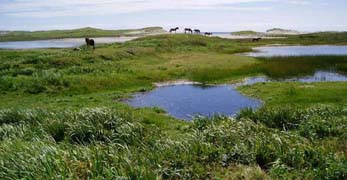
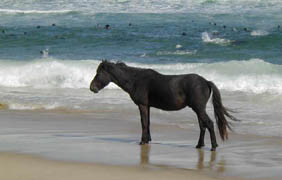
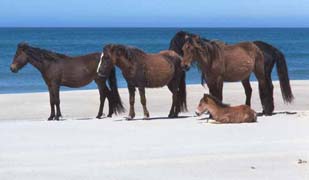
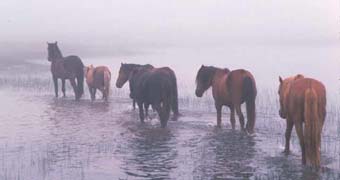
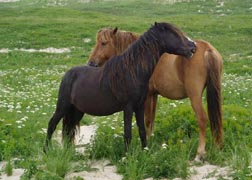
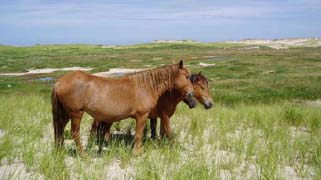
|
Sable Island
Sable Island, with a surface area of about 3400 ha, has a topography comprised of beaches, sand dunes, inland fields of grass and heath, and freshwater ponds. The physiography of the island is the result of atmospheric and oceanic influences. The shape and position of the dunes reflect the prevailing westerly wind direction and storm trends. Ocean currents, waves, and tides modify the width and contour of the beaches and change the dimensions of east and west spits.
Weather on Sable Island is not as harsh as is usually imagined. The island's climate is temperate oceanic and is generally milder than that of mainland Nova Scotia. Winter temperatures, normally between +5 and -5°C, rarely drop below -13°C Summer temperatures peak in August at 25°C. Prevailing winter winds are northwesterly and blowing 20 knots most days, and summer winds are southwesterly and lighter, blowing 10 knots. Sable Island is the windiest place in Nova Scotia, and has the least sunshine and the most fog.
Only a handful of people - mostly staff of the Sable Island Station - live and work on the island year-round. While the primary role of the station is collection of weather data and atmospheric research, the station also provides essential infrastructure and security for other human activities on the island. These include maintenance of aids to navigation, scientific research on flora and fauna, and support services for the offshore energy industry.
A variety of plants and animals are found on Sable Island. About 40% of the land surface area is vegetated. Over 175 plant species are found in several distinctive plant communities. These include the sandwort colonies of the east and west ends of the island; shrub-heath and cranberry communities dominated by crowberry, bayberry, wild rose, blueberry and cranberry; and richly vegetated freshwater pond and pond edge communities. In summer and autumn the island is cloaked with lush, green vegetation and wildflowers (including six species of orchid); in winter and early spring the dunes are rather bleak, grey and windswept, and appear deceptively devoid of vegetation. Except for one small pine surviving from a planting near the weather station some forty years ago, there are no trees on the island.
All information is re-produced here with kind permission from the Green Horse Society. All photographs copyright and produced with permission from Zoe Lucas. |
